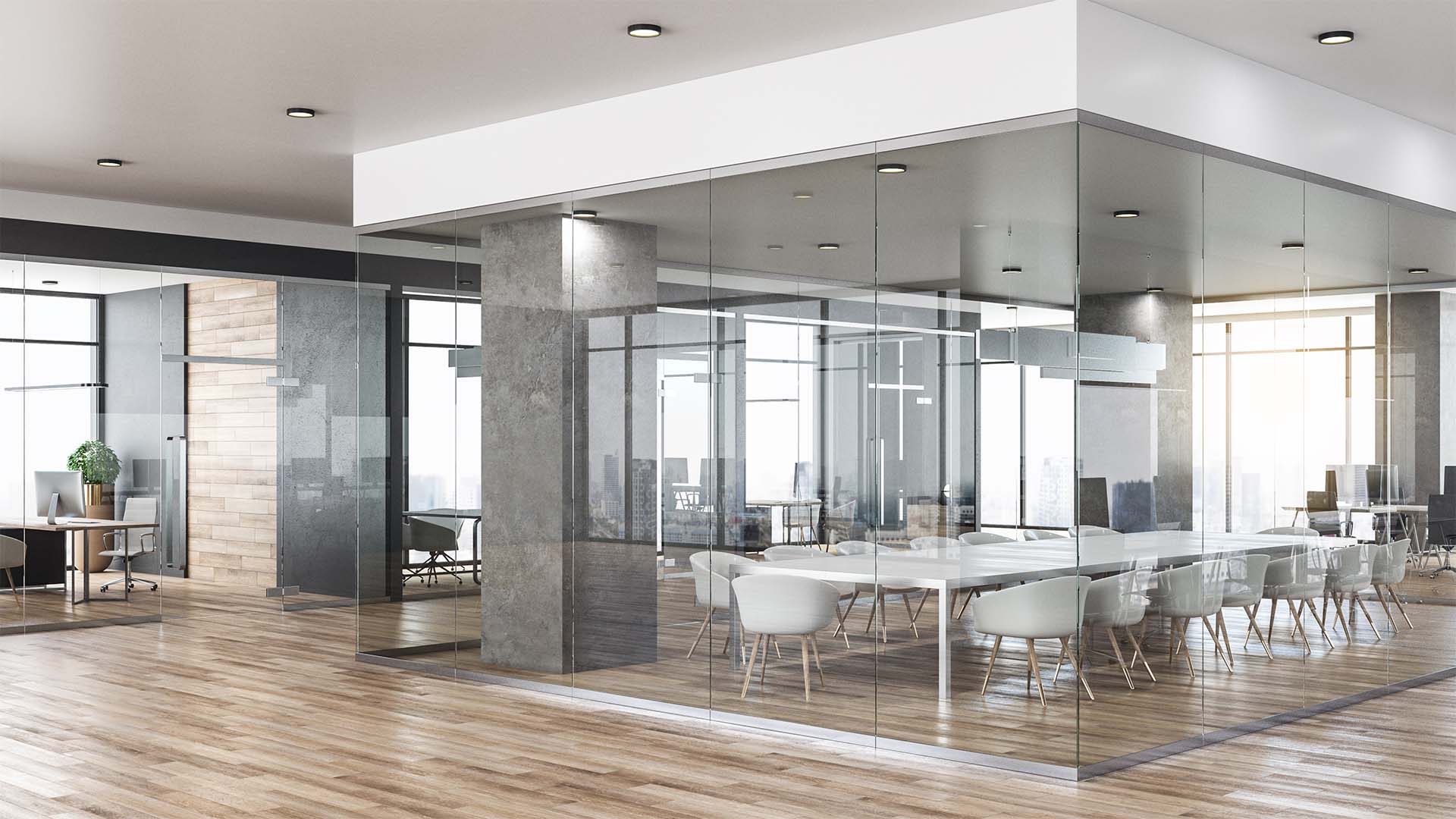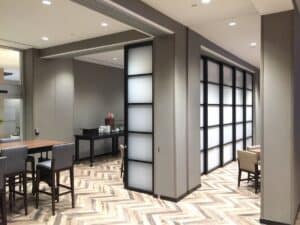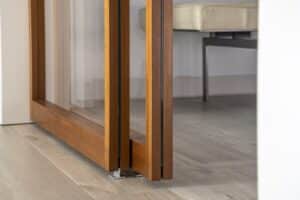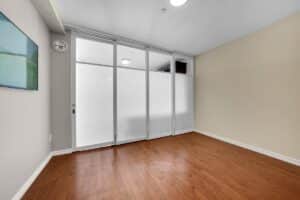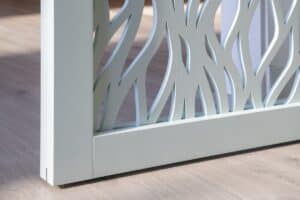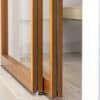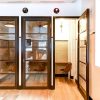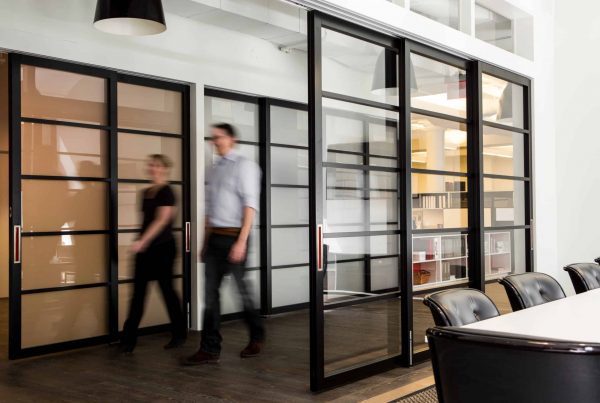Summary
- Acrylic is a lightweight, shatter-resistant alternative to glass that’s easier to install, operate, and maintain in sliding door systems.
- Raydoor acrylic inserts offer superior clarity and privacy options while reducing costs and stress on hardware.
- Tempered and low-iron glass provide a more traditional feel with added acoustic performance and visual transparency.
- Acrylic supports greater design flexibility, particularly in stacking and folding wall systems where weight matters.
- Both glass and acrylic are available in most Raydoor systems—let your space’s needs, aesthetic, and function guide you to the right choice.
The materials you choose to partition your interior spaces impact everything from installation to everyday usability. Glass and acrylic panels offer very different benefits for sliding doors and operable walls.
Many people simply assume glass is the only option because they don’t know acrylic solutions exist. But in some cases , the unique benefits of acrylic glazing make it worth serious consideration—especially in modern spaces with flexible needs.
At Raydoor, we’ve been using lightweight acrylic inserts in our TWINFRAME® system for more than two decades. More recently, we’ve also begun offering tempered and low-iron glass in many of our door and wall solutions to meet the evolving needs of our clients. Both materials have their place—it’s all about understanding when to use which.
This guide breaks down the pros and cons of acrylic vs. glass in the context of interior sliding doors and wall systems to help you make an informed decision.
What Is Acrylic Glazing?
Acrylic glazing is a lightweight, shatter-resistant resin sheet that’s available in a wide variety of:
- Colors and tints
- Opacities
- Textures and patterns
Raydoor acrylic inserts are available in several decorative styles, including translucent and opaque finishes that enhance both natural light transmission and privacy.
What Is Tempered Glass?
Tempered glass used in interior walls and doors is heat-treated for safety. In some cases, it’s laminated with a plastic interlayer to prevent dangerous shattering.
The glass panels we use in Raydoor systems are:
- Available in standard tempered or low-iron clear for better clarity
- Thicker and heavier than acrylic, requiring reinforced support
- Designed to enhance both visual openness and acoustic separation
Learn More: Interior Glass Door and Wall Design: A Complete Guide
Acrylic vs. Glass for Doors & Walls
Use this chart to compare key performance and design factors between the two materials:
| Criteria | Glass | Acrylic |
|---|---|---|
| Safety | Must be tempered or laminated—adds cost | Naturally impact-resistant and flexible |
| Weight | Roughly twice as heavy as acrylic for the same panel size | Lightweight—easier to ship, handle, and install |
| Optical Clarity | High only with premium (low-iron) glass | Very high across most styles |
| Installation | Requires heavy-duty support and large crews | Installs easily with minimal equipment |
| Design Flexibility | Limited by weight—larger panels require thicker frames | Enables slimmer or more stylized framing |
| Ease of Use | Heavier weight makes sliding more difficult | Glides effortlessly due to reduced weight |
| Repairability | Durable; minor scratches manageable on unlaminated panels | Surface scratches can be polished out on untextured acrylic |
| Maintenance | Higher wear on hardware due to weight | Less hardware strain = fewer maintenance issues |
| Recyclability | Tempered and laminated glass are hard or impossible to recycle | Highly recyclable—Raydoor’s Opal is up to 100% recycled content |
| Price | Higher due to material, shipping, and labor costs | Lower cost of materials and simpler installation |
Which Raydoor Systems Work with Acrylic?
Acrylic inserts can be used in all Raydoor product categories, including:
- Sliding doors and walls (single, bypass, wall, wing wall, pocket, stacking)
- Folding doors and folding wall systems
- Demountable systems for modular room division
Popular applications include:
- Glass-like office partitions with less weight
- Residential sliding panels with privacy inserts
- Conference room dividers that maximize natural light
- Lightweight room dividers for high-traffic commercial spaces
When Should You Choose Acrylic?
Choose acrylic when you prioritize:
- Easier installation with lower labor and equipment needs
- Better impact resistance and reduced risk of breakage
- Lightweight operation that’s ideal for sliding and stacking
- Cost savings on both product and install
- Design flexibility with more insert and framing options
Acrylic also performs exceptionally well in high-use spaces, which include:
- Commercial offices
- Hospitality venues
- Multipurpose rooms
- Residential interiors with adaptable layouts
Raydoor Glass Systems: What to Know
Raydoor now offers tempered and low-iron glass inserts in many systems. These are ideal when:
- Acoustic performance is a priority
- You want unmatched visual clarity
- A more traditional glass aesthetic is desired
Our glass systems are available in:
- Multiple sliding, folding, and stacking configurations
- Narrow stile framing options for a sleek, contemporary appearance
- Wood veneer frame options for a warmer, custom look
Ready to Choose the Right Glazing for Your Space?
Whether you’re designing a collaborative workspace, a private office, or a flexible living area, choosing the right panel material is key to balancing aesthetics, performance, and ease of use. Both acrylic and glass have strengths—what matters most is how those strengths align with your space’s function and your design vision.
At Raydoor, we’ll walk you through the options and help you design a system that works as beautifully as it looks.
Request a quote today to speak with a Raydoor consultant and get expert guidance on the best material, configuration, and finish for your doors or walls. We’re here to help you get a clear vision of the best options for your space.
Mini FAQ: Raydoor Glass vs. Acrylic
Can I mix glass and acrylic in the same system?
Yes. Our design team can help you blend materials strategically for both function and appearance.
Is acrylic more prone to scratching?
It can scratch more easily than glass—but many minor scratches can be buffed or polished out, especially with untextured inserts.
Does glass offer better sound control?
Tempered glass generally provides better acoustic separation, especially when paired with gaskets and thresholds.
Which material is better for large openings?
Acrylic is often preferred due to its lightweight properties, but Raydoor stacking and pocket walls with tempered glass are also an option for larger spans.
Is acrylic less “premium” than glass?
Not at all. Acrylic inserts can look just as high-end—especially with decorative finishes, clean lines, and refined wood frames. Explore all of our design options here.
